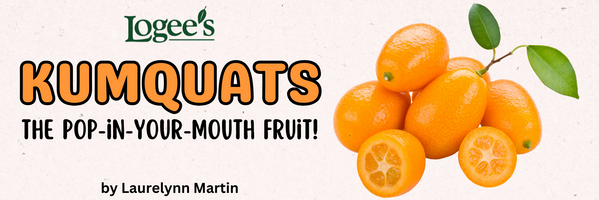Kumquat Trees - Grow Your Own Tasty Kumquats at Home!

Kumquats are delightful citrus fruits known for their petite size and unique consumption method – you eat them whole, skin and all! Native to southern Japan and China, these little gems have a sweet, thin rind contrasted by a slightly tart flesh. They are typically oval or round in shape, and measure about 1-2 inches in length. Perfect for container gardening, kumquat trees are evergreen, bearing fragrant white blossoms that give way to an abundance of vibrant orange fruits. Some kumquat varieties are sweet on the outside and tart on the inside, while others are sweet all the way through.
Kumquats were introduced to Europe in 1864 by Robert Fortune, a collector from the London Horticultural Society. Shortly thereafter, this tasty little citrus made its way to North America. In 1915, Kumquats were no longer classified as Citrus japonica but were named after Mr. Fortune, and the new genus became Fortunella. Rich in vitamin C, kumquats can be enjoyed fresh, candied, or in jams and jellies. If you're looking for a unique citrus addition to your garden that doubles up as an ornamental piece and offers a zesty treat, kumquats are an excellent choice!
At Logee’s, we grow the following three varieties of kumquats. We grow them as grafted plants rather than cuttings because they don’t root readily and grafting the named variety onto an understock increases vigor and encourages early fruiting. We typically use Citrumelo or C. macrophylla as the rootstock. They thrive best in full sun and require moderate watering. (Additional kumquat tree care information can be found below.)
Changshou Kumquat Tree (Fortunella obovata ‘Fukushu’)
Rare and hard-to-find, the Changshou Kumquat is grown for its large juicy fruit. Fragrant white flowers bloom from May to September with the fruit ripening year-round. Changshou’s pear-shaped fruit is larger than other kumquat varieties and it usually has five or six segments of fruit inside the sweet, thin skin. We’ve been working for the past five years to bring the Changshou, or ‘Fukushu,’ kumquat to the US market since we think it’s the best kumquat we’ve grown and it makes a perfect potted specimen. In China and Japan, the Changshou Kumquat is used as an ornamental container plant for the home since it creates a lovely small decorative tree with the added appeal of healthy fresh fruit. This is a grafted plant shipped in a 4" pot that blooms and fruits sooner.
Kumquat Tree ‘Nagami’ (Fortunella margarita)
Kumquats are a favorite citrus fruit among people of all ages. Their thin outer skin is sweet and their inner pulp is surprisingly tart. Kumquats are meant to be eaten skin-and-all, so in combination, the taste is a distinctive flavor. The fruit of the ‘Nagami’ kumquat is oval and about 1 1/4” long x 1” diameter. Our grafted plants, shipped in 4” pots, will give you a jump on flowering and fruiting. Within one year, they will flower in the summer and set fruit just in time for the holidays. At Logee’s our kumquat tree has taken its permanent residence in our greenhouses for over 100 years. As with all citrus, keep the roots healthy by drying out between waterings and give full light and moderate amounts of fertilizer for steady growth.
Sweet Kumquat Tree ‘Meiwa’ (Fortunella crassifolia)
Kumquat 'Meiwa’ is known as the Sweet Kumquat with the typical golden-orange colored fruit that other kumquats have. Yet eating a ‘Meiwa’ kumquat is a delight unto itself. Pop the entire large gumball-sized fruit into your mouth and allow the sweet flavors to permeate your senses. ‘Meiwa’ is not available commercially like ‘Nagami’ (the oval kumquat), but they are easily grown in a home environment as long as you have a sunny window and keep the root system healthy by drying the soil a little between waterings. The highly fragrant blooms arrive in summer with fruit ripening during the winter, usually from December through April. This is the perfect plant to give you that vitamin C boost in the dead of winter. Our grafted plant blooms and fruits sooner.
Growing Kumquats
Kumquat trees are unique citrus gems, producing vibrant, small, and edible fruit with a sweet peel and tart flesh. Easy to grow in containers, they're perfect for patios and exude a delightful fragrance when in bloom. Keep these care tips in mind and your kumquat tree will delight your eyes, nose and taste buds for years to come!
Kumquat Tree Light Requirements
Full to partial sun is required for growing kumquats. The more light the better, but as with all citrus, they can be grown indoors on an east or west-facing window and flower and produce fruit.
Flowering/Fruit
The flowering cycle for kumquats is later than most citrus. They flower in late spring into early summer with the Changshou often flowering twice a year, making it an almost ever-bearing plant. The sweetly fragrant blossoms are followed by fruit that ripens in mid-winter for us with the fruit holding onto the trees well into late spring. They bear a heavy crop at a young age making them excellent specimens for a container fruit garden.
Soil/Hardiness Zone
Kumquats are well adapted to most well-drained potting mixes. We grow them in a standard soilless mix that has a pH around 6. For outdoor growing, kumquat plants are cold hardy to Zone 8b and upper 9 and are known to be some of the more cold tolerant citrus. The Changshou is thought to be more cold sensitive than the other species.
Fertilizer
Moderate amounts of fertilizer are needed during the active growing season. Reduce and restrict fertilizer when going into the winter season. There are several excellent citrus fertilizers on the market but any organic balanced fertilizer will work. We like to top dress the soil, because it slowly releases fertilizer to the plant over a period of time.
Pruning a Kumquat Tree
When the kumquat plant is young, pinch back the growing tips and shoots to make the plant full and bushy. This encourages a sturdy well-branched structure so it can carry the future fruiting load. Keep in mind that kumquats bear so heavy that they can bend the limbs to the point of breaking on young plants. Older plants need to be pruned periodically to maintain shape and this is best done after fruiting. On mature plants, it’s best to selectively prune top branches that are too tall or reaching out but leave the inner and side growth so you don’t lose next year’s fruit. A branch or lead that is cut in late spring or early summer generally won’t flower until the following year.
Pest/Disease Problems
Scale, spider mite and mealy bug can be problems on citrus. Attention needs to be given when moving plants indoors in late summer or early fall. A preventative spraying of neem oil twice in one-week intervals will do wonders to keep the kumquat tree clean throughout the winter. This is especially true if scale and mealybug have been a problem in the past. Spider mites often come in with plants that have summered outside and are not visible until the dry atmosphere of the winter home causes populations to explode. Root disease is only a problem if the plant is kept too wet and grown in cold damp conditions. We recommend growing in a clay pot and erring on the dry side when watering. Also, if you have a grafted plant that has been grown on a disease resistant understock, then root disease becomes less of a problem.
Special Requirements for Grafted Plants
Remember when grafted kumquat plants are young, shoots can develop below the graft union on the rootstock. These shoots need to be removed, otherwise they will dominate the plant and the grafted kumquat variety will stay small and barely grow. As plants get older, this rootstock suckering slows down or stops.
Additional Kumquat Tree Information
- View All Kumquat Plants
- Download Kumquat Tree PDF Care Sheet
- Article: Caring for Grafted Plants
- Please refer to the video below for additional information on how to care for your kumquat tree:




